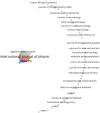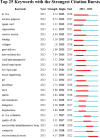Global research trends of nanotechnology for pain management
- PMID: 37701493
- PMCID: PMC10494532
- DOI: 10.3389/fbioe.2023.1249667
Global research trends of nanotechnology for pain management
Abstract
Background: Nanotechnology has been increasingly used in healthcare during recent years. However, the systematic evaluation of research on nanotechnology for pain management is lacking. In this study, we employed a bibliometric approach to examine the status of the research and global trends of nanotechnology in relation to pain management. Methods: We selected relevant papers published in the Web of Science Core Collection database between 2013 and 2022 using search terms related to nanotechnology and pain management. Subsequently, the following bibliographic information was collected: publication year, originating country/region, affiliated authors and institutions, published journal, references cited, citation frequency, and keywords. The bibliometric software programs VOSViewer and CiteSpace were employed to obtain bibliometric statistics and perform visual analysis. Results: A total of 2680 papers were retrieved. The number of publications in the field of nanotechnology for pain management has been increasing annually since 2013. China had the highest number of published papers, whereas the United States led in total citations. The Chinese Academy of Sciences was the most prolific institution, while the Tehran University of Medical Sciences had the highest overall citations. Furthermore, De Paula was the most prolific author. Papers associated with nanotechnology for pain management were mainly published in the International Journal of Pharmaceutics, Pharmaceutics, and the International Journal of Nanomedicine. Keyword analysis showed that "in-vitro" and "drug-delivery" appeared most frequently, with the top 10 common keywords comprising nanoparticles, pain, in-vitro, drug-delivery, delivery, release, inflammation, neuropathic pain, formulation, and expression. Lastly, the latest emerging keyword was "electrochemical sensor". Conclusion: Research on applying nanotechnology for pain management is growing steadily. China is the top country in terms of number of publications, with institutions under the Chinese Academy of Sciences making significant contributions to this field. "In-vitro" and "drug-delivery" are the current hotspots in this area, with "electrochemical sensor" as the latest topic at the research forefront. However, national and inter-institutional collaborations should be strengthened to enable patients with pain disorders to benefit from nanotechnology implementation in pain management.
Keywords: VOSviewer; bibliometrics; citespace; nanotechnology; pain management; trends; visualisation.
Copyright © 2023 Zhu, Yao, Kuang, Chen, Du and Qu.
Conflict of interest statement
The authors declare that the research was conducted in the absence of any commercial or financial relationships that could be construed as a potential conflict of interest.
Figures









References
Publication types
LinkOut - more resources
Full Text Sources

